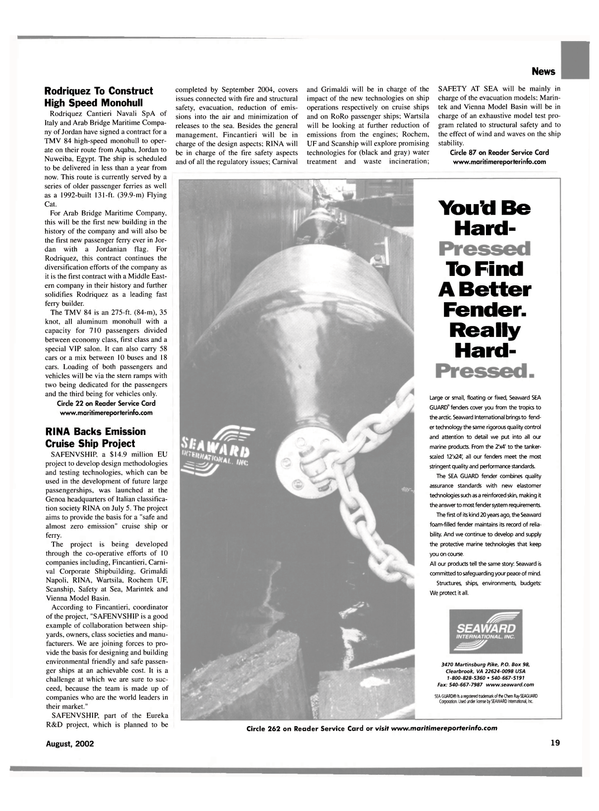
Cutting Edge Know-How to Cut Smoke
As a further vindication of major Greek investment in marine propulsion research, the state-of-the-art. engine test laboratory inaugurated less than two years ago at the National Technical University of Athens (NTUA) will contribute to a new European project to reduce diesel engine smoke emissions.
Co-ordinated by the Greek C1MAC Association, the EU-sponsored collaborative research program, dubbed Smokermen, was implemented at the outset of July this year, with an intended 36- month duration.
The NTUA's Laboratory of Marine Engineering will lend its experimental testing resources and mathematical modeling expertise to the endeavor, which aims to cut smoke emissions to below the visible limit in transient and low-load conditions.
The EU is providing around 50-percent funding support for the ambitious project, which also involves partners from Germany, the Netherlands and Switzerland, in the shape of classification society Germanischer Lloyd, engine control systems specialist Woodward Governor Nederland and turbocharger maker ABB Turbo Systems. Smokermen is focused on medium-speed and highspeed diesel plant, and aims to curb smoke formation during the critical load phases by improving the air-charging of main and auxiliary engines.
The impulse for the program has come from shipping company members of the Greek chapter of CIMAC, who have raised concerns over engine smoke emissions, aware of the growing environmental sensitivities associated with smoke from ships' stacks. Greek CIMAC members also intend to make vessels available for onboard measurements, a vital part of the research undertaking.
The project will evaluate two technologically- advanced solutions to the problem of fuel-air mismatch, which manifests itself during transient loading and leads to increased smoke output.
Two prototype systems and the respective engine control arrangements will be developed and installed on a marine diesel engine on a testbed. to evaluate performance.
The techniques, which will be used for the prototypes, will be high-pressure air injection to accelerate the turbocharger and feed the engine at the onset of a transient load condition, and advanced pulse turbocharging with variable geometry manifold.
Read Cutting Edge Know-How to Cut Smoke in Pdf, Flash or Html5 edition of August 2002 Maritime Reporter
Other stories from August 2002 issue
Content
- QM2 Celebrates Keel Laying At French Shipyard page: 6
- San Fernando Shipyard Gets A RoPax Ferry Order page: 6
- Austal Delivers Lilia Concepcion To Venezuela page: 8
- Navy Christens New Guided Missile Destroyer page: 9
- Northrop Grumman Delivers USNS Brittin page: 9
- New & Notable Empress of the North Scheduled For 2003 page: 10
- Austal USA Sells Second Vessel Into N.Y. Market page: 11
- Guangzhou Panyu Lingshan Shipyard Prepare for Deliveries page: 13
- VDR and AIS Regulations Go Into Effect page: 14
- Maritime Security and the Hazards of Unilateralism page: 15
- Keppel Acquires Interest in Verolme Botlek for $17.9 Million page: 16
- After Half A Century, Hamilton Jet Keeps On Pushing page: 18
- Rodriquez To Construct High Speed Monohull page: 19
- RINA Backs Emission Cruise Ship Project page: 19
- Vosper Thornycroft Takes A "Bite" Out of Technology page: 20
- Cutting Edge Know-How to Cut Smoke page: 21
- South China Yard Holds Court In Pearl River Delta page: 22
- MarAd's Schubert: Building a Better U.S. Business page: 24
- Opportunities Plentiful page: 27
- Derecktor Cuts First Plate of AMHS Ferry page: 29
- Gulf Craft Delivers World's Largest Crew/Supply Vessel page: 31
- Raising the Kursk page: 32
- Spiegel Grove: Saved to be Sunken page: 34
- Titan Re-Floats Clipper Cheyenne page: 38
- Using a Simulator With Eyes Wide Open page: 39
- ChartCo Is Successful During Sea Trials page: 41
- Ultra Large Containerships: Will Security Measures Impede Operations? page: 43
- Premiere Maritime Security Exhibition to be Held in NYC page: 47
- Get Ready for the New OPA 90 page: 48
- M/V Tanner Christened In Texas page: 49
- Rolls-Royce Helps Power Combat Boat Success page: 50
- SMI: Helping to Spread British Marine Technology Worldwide page: 51
- McNeece Unveils Unique Hull Concept page: 52
- Ultrajets Chosen by FBM Babcock for Military Project page: 54
- New Cutter for Port of London Features Cat Power page: 55


